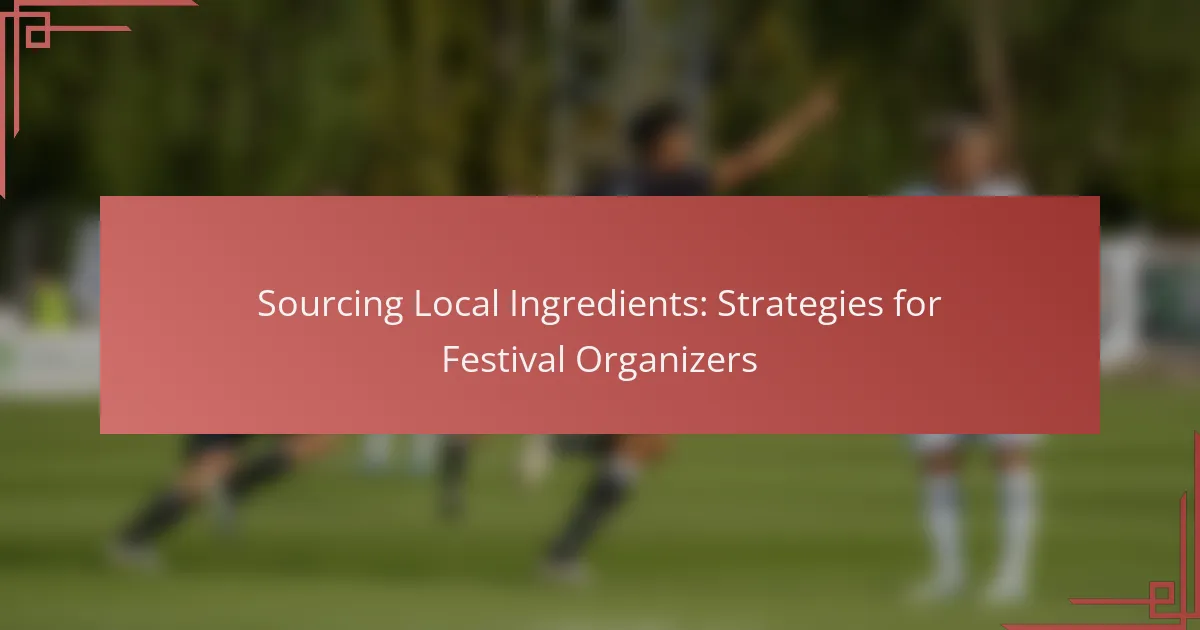Sourcing local ingredients is a vital strategy for festival organizers looking to enhance their events while supporting regional economies. By building strong relationships with nearby farms and suppliers, organizers can ensure fresh, high-quality offerings that resonate with attendees. Implementing seasonal menus and educating staff further enriches the festival experience and promotes sustainability.

How can festival organizers source local ingredients in the US?
Festival organizers in the US can effectively source local ingredients by establishing connections with nearby farms, markets, and distributors. This approach not only supports local economies but also enhances the festival’s appeal through fresh, regional flavors.
Partnering with local farms
Collaborating with local farms is a direct way to obtain fresh ingredients. Organizers should identify farms within a reasonable distance from the festival site, ideally within 50 to 100 miles, to ensure freshness and reduce transportation costs.
Consider establishing long-term relationships with these farms, which can lead to better pricing and priority access to seasonal produce. Organizers can also negotiate contracts that guarantee a certain quantity of ingredients, helping farms plan their harvests accordingly.
Utilizing farmers’ markets
Farmers’ markets are excellent venues for sourcing local ingredients. Organizers can visit these markets to meet vendors, sample products, and negotiate bulk purchases directly. This face-to-face interaction fosters trust and can lead to better deals.
It’s beneficial to attend markets that are held regularly, such as weekly or bi-weekly, to build relationships with multiple vendors. This strategy allows organizers to diversify their ingredient sources and adapt to any last-minute changes in availability.
Engaging with local food cooperatives
Local food cooperatives often have established networks of farmers and producers, making them valuable partners for sourcing ingredients. By joining or collaborating with these co-ops, festival organizers can access a wider range of products at competitive prices.
Cooperatives may also offer seasonal buying options, which can help organizers plan their menus around what is freshest and most abundant. Additionally, co-ops often emphasize sustainable practices, aligning with the growing consumer demand for environmentally friendly options.
Collaborating with regional distributors
Regional distributors can streamline the sourcing process by providing a variety of local ingredients from multiple farms. This option is particularly useful for larger festivals that require significant quantities of food.
When selecting a distributor, organizers should prioritize those that specialize in local products and have a good reputation for quality. Establishing a clear communication channel with distributors can help ensure timely deliveries and consistent quality throughout the festival.

What are effective strategies for sourcing local ingredients?
Effective strategies for sourcing local ingredients include building strong relationships with local suppliers, implementing a seasonal menu, and conducting workshops to educate staff and vendors. These approaches not only enhance the quality of food served at festivals but also support the local economy and promote sustainability.
Building relationships with suppliers
Establishing solid connections with local suppliers is crucial for consistent access to fresh ingredients. Attend farmers’ markets, food expos, and local trade shows to network with potential vendors. Regular communication and visits to farms can foster trust and reliability.
Consider creating long-term partnerships with a few key suppliers rather than relying on multiple sources. This can lead to better pricing, priority access during peak seasons, and the ability to customize orders based on your festival’s needs.
Implementing a seasonal menu
Designing a seasonal menu allows festival organizers to take advantage of the freshest local produce available. This approach not only enhances flavor but also reduces costs associated with transporting out-of-season ingredients. Research local harvest calendars to align your menu with peak availability.
For example, if your festival occurs in summer, prioritize ingredients like tomatoes, zucchini, and berries. This strategy can also create excitement among attendees, as they experience unique dishes that reflect the local agricultural landscape.
Conducting local ingredient workshops
Hosting workshops focused on local ingredients can educate both staff and attendees about the benefits of sourcing locally. These sessions can cover topics such as the importance of seasonal eating, cooking techniques, and the stories behind local farms.
Invite local chefs or farmers to lead these workshops, providing hands-on experiences that engage participants. This not only enriches the festival experience but also strengthens community ties and encourages support for local agriculture.

What criteria should be considered when selecting local suppliers?
When selecting local suppliers for festival ingredients, consider quality, reliability, and pricing. These factors ensure that the ingredients meet your standards, are delivered on time, and fit within your budget.
Quality and freshness of ingredients
Quality and freshness are paramount when sourcing local ingredients. Fresh produce not only enhances the taste but also attracts attendees who prioritize local and sustainable options. Look for suppliers who can provide seasonal ingredients, as these are often fresher and more flavorful.
Consider conducting taste tests or requesting samples before finalizing your supplier. This will help you assess the quality of their offerings and ensure they align with your festival’s culinary vision.
Supplier reliability and delivery schedules
Reliability in suppliers is crucial for smooth festival operations. Ensure that your chosen suppliers have a track record of timely deliveries and can handle the volume you require. Check references and reviews from other event organizers to gauge their reliability.
Establish clear delivery schedules and contingency plans for potential delays. Having backup suppliers can mitigate risks associated with last-minute changes or supply chain disruptions.
Pricing and payment terms
Pricing is a significant factor when selecting local suppliers. Compare quotes from multiple suppliers to ensure you are getting competitive rates. Be mindful of the total cost, including delivery fees and any potential discounts for bulk orders.
Negotiate payment terms that work for both parties. Some suppliers may require upfront payments, while others might offer net terms. Clear agreements can prevent misunderstandings and ensure a smooth transaction process.

How can technology assist in sourcing local ingredients?
Technology can significantly enhance the process of sourcing local ingredients by streamlining connections between festival organizers and local producers. Utilizing various digital tools can simplify the search, improve communication, and ensure a more efficient procurement process.
Using sourcing platforms like LocalHarvest
Sourcing platforms such as LocalHarvest provide a centralized database of local farms and producers, making it easier for festival organizers to find and connect with suppliers. These platforms often include filters for specific ingredients, allowing users to search based on their festival’s needs.
When using these platforms, consider the geographic area and the types of products needed. Many farms may have seasonal offerings, so it’s beneficial to check availability well in advance of the festival date.
Leveraging social media for connections
Social media platforms can be powerful tools for connecting with local farmers and food producers. By following relevant hashtags or joining community groups, festival organizers can discover potential suppliers and engage directly with them.
It’s advisable to post inquiries or shout-outs on platforms like Instagram or Facebook, as local producers often monitor these channels for opportunities. Building relationships through social media can lead to better deals and collaborations.
Implementing inventory management software
Inventory management software helps festival organizers track ingredient availability and manage orders efficiently. By keeping real-time data on stock levels, organizers can avoid over-ordering or running out of essential items during the event.
Choose software that integrates with sourcing platforms to streamline the ordering process. This integration can save time and reduce errors, ensuring that all local ingredients are accounted for and properly managed throughout the festival planning stages.

What are the benefits of sourcing local ingredients for festivals?
Sourcing local ingredients for festivals offers numerous advantages, including economic support for nearby farmers and producers, improved food quality, and a smaller environmental impact. These benefits contribute to a more sustainable and community-focused festival experience.
Supporting local economies
When festivals prioritize local ingredients, they directly benefit the surrounding economy by providing financial support to local farmers and vendors. This practice keeps money within the community, fostering growth and sustainability.
Additionally, sourcing locally can create job opportunities in agriculture and food service, enhancing the overall economic landscape. Engaging local businesses can also lead to partnerships that strengthen community ties.
Enhancing food quality and flavor
Local ingredients are often fresher and more flavorful than those transported over long distances. This freshness can significantly enhance the taste of dishes served at festivals, leading to a more enjoyable experience for attendees.
Moreover, local producers typically grow varieties that are well-suited to the region’s climate, resulting in higher quality produce. Chefs can create unique dishes that highlight local flavors, appealing to both locals and visitors.
Reducing carbon footprint
Sourcing ingredients locally helps to minimize transportation emissions, significantly reducing the overall carbon footprint of a festival. By cutting down on the distance food travels, festivals can contribute to a more sustainable food system.
Additionally, local sourcing often encourages more environmentally friendly farming practices, as smaller farms may prioritize sustainability over mass production. This approach not only benefits the environment but also promotes a healthier food ecosystem.

What challenges do festival organizers face in sourcing local ingredients?
Festival organizers often encounter difficulties in sourcing local ingredients due to factors like seasonal availability and logistical issues. These challenges can impact the quality and variety of food offerings at events, making it essential to plan effectively.
Seasonal availability of products
Seasonal availability significantly affects the sourcing of local ingredients. Many fruits, vegetables, and herbs are only available during specific times of the year, which can limit options for festival menus. For instance, strawberries may only be in season from late spring to early summer, while root vegetables are typically harvested in the fall.
To navigate this challenge, organizers should create a seasonal calendar that outlines when various ingredients are available. This helps in planning menus that align with local harvests, ensuring freshness and supporting local farmers. Engaging with local producers early can also provide insights into what will be available.
Logistical issues in transportation
Logistical issues in transportation can complicate the sourcing of local ingredients. Factors such as distance from suppliers, transportation costs, and the perishability of products must be considered. For example, transporting fresh produce over long distances can lead to spoilage, impacting quality and increasing waste.
To mitigate these logistical challenges, festival organizers should establish relationships with local suppliers who can deliver ingredients directly to the event site. Utilizing a just-in-time delivery approach can help ensure that ingredients arrive fresh and reduce storage needs. Additionally, planning transportation routes and schedules in advance can help streamline the process and minimize delays.



